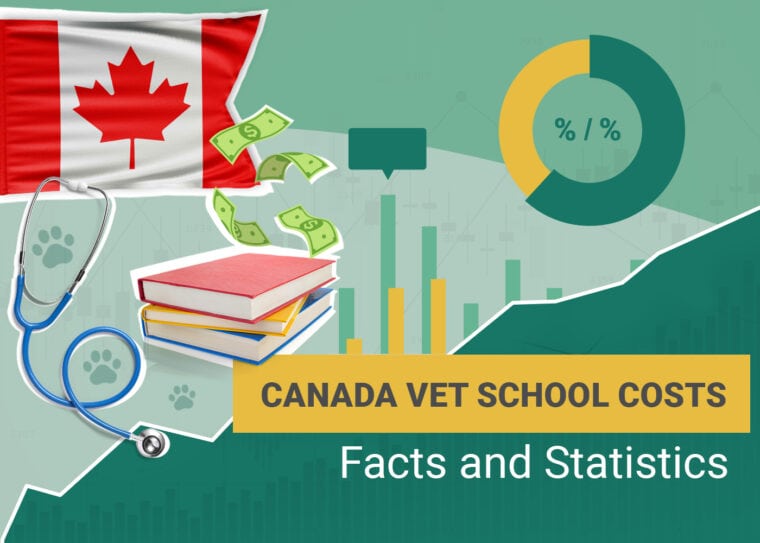
Click to Skip Ahead
Note: This article’s statistics come from third-party sources and do not represent the opinions of this website.
Have you ever wondered how much it costs to go to vet school in Canada? How much a veterinarian makes? Whether it’s easy to get into vet school? We have the answers to these questions and more!
An undergraduate degree in pre-veterinary studies costs CAD $16,000–$98,000, and a graduate degree in veterinary medicine is $12,000–$70,000.1 Read on to learn more facts and statistics about the veterinary industry and veterinary schools in Canada.
The 10 Canada Veterinary Statistics
- The average cost of a graduate degree in veterinary medicine is $12,000–$70,000.
- The full-time median annual income for a veterinarian in Canada is $97,477.
- There are over 15,000 veterinarians in Canada as of 2023.
- There are 5,796 veterinary practices in Canada.
- The veterinary industry employs 52,518 people.
- Canada has only five veterinary schools.
- Approximately 450 new veterinarians graduate every year in Canada.
- 64% of veterinary graduates are female, while only 35% are male.
- The acceptance rate for vet schools is between 10% and 15%.
- The University of Guelph’s Ontario Veterinary College is rated as the number-one vet school in Canada.

Financial Statistics
1. The average cost of a graduate degree in veterinary medicine is $12,000–$70,000.
(SI-Canada)
This rate is specifically to go through the Doctor of Veterinary Medicine program. The estimated cost of an undergraduate degree in pre-veterinary studies is $16,000–$98,000. These rates are based across the five veterinary schools in Canada and are tuition only so do not include accommodations or other necessities.

2. The full-time median annual income for a veterinarian in Canada is $97,477.
(Talent.com)
Salaries for veterinarians range from $49,382 to $137,500 across the country. Alberta reports the highest salary range with a median salary of $125,000, while Québec reports the lowest with a median of $49,382.
Whether this average is representative of veterinarians across the country is unclear, however, as there is no data available for Newfoundland and Labrador, the Northwest Territories, Nunavut, Prince Edward Island, or Yukon Territory.
General Canadian Veterinary Industry Statistics
3. There are over 15,000 veterinarians in Canada as of 2023.
(CVMA)
This number is representative of the total number of veterinarians registered with provincial regulatory bodies and the Canadian Veterinary Medical Association.

4. There are 5,796 veterinary practices in Canada.
(IBIS World)
Veterinary businesses include animal hospitals, disease testing, livestock inspecting, and testing, small animal veterinary services, and veterinary testing laboratories.
5. The veterinary industry employs 52,518 people.
(IBIS World)
The industry as a whole is worth $6 billion. This figure does not include individuals employed by companies that manufacture medical supplies or animal pharmaceuticals.
General Veterinary School Statistics
6. Canada has only five veterinary schools.
(The Canadian Encyclopedia)
There are five Canadian Colleges of Veterinary Medicine. These are:

7. Approximately 450 new veterinarians graduate every year in Canada.
(University of Saskatchewan)
This is considered a dire shortage, one exacerbated by the COVID-19 pandemic, among other factors. The Western College of Veterinary Medicine has responded by increasing its class sizes and is also working with the Canadian Veterinary Medical Association and other provincial partners to raise financial support and student quotas.
8. 64% of veterinary graduates are female, while only 35% are male.
(CVMA)
These demographics are based on CVMA memberships for 2023.
9. The acceptance rate for vet schools is between 10 and 15%.
(BeMo)
There are just under 300 spots available each year for admission into Veterinary Colleges. This makes it the hardest program to get into in the country, with between 700 and 1,000 rejected applications for each successful applicant. The extreme level of competition makes for unforgiving entrance requirements.

10. The University of Guelph’s Ontario Veterinary College is rated as the number one vet school in Canada.
(EduRank)
It’s also the third-best-rated veterinary school in North America and the fourth best in the world, topped only by UC Davis, Cornell University, and Utrecht University.
- Related Read: Interesting UK Vet Statistics
Frequently Asked Questions
Is there a high demand for veterinarians in Canada?
The demand for veterinarians in Canada is extremely high. With a limited number of spots available in veterinary colleges each year, it is one of the most in-demand careers, especially for individuals considering emigrating to the country. Qualified veterinarians are eligible for Permanent Residency through the Federal Skilled Worker Immigration Program on a Federal and Provincial Nomination basis.
(CVMA, VETERINARYmoda)
What are the admission requirements for vet schools in Canada?
Admission requirements differ slightly between the veterinary colleges, particularly regarding residency. Some colleges are open to applicants from all provinces, such as the University of Guelph, while others are only available to students from their home province. As an example, here are the entry requirements for the DVM program at the University of Calgary.
(University of Calgary)

What are the licensing requirements for veterinarians in Canada?
Graduates of non-accredited veterinary schools are required to complete a National Examination Board examination sequence to receive a Certificate of Qualification.
Graduates of accredited veterinary schools must pass the NAVLE within two attempts to receive licensure. If a candidate requires more than two attempts to pass the exam, a hands-on practical component is also required.
(OzTREKK)
- Related Read: Types of Veterinarians and What They Do
Conclusion
Veterinary school in Canada is expensive. There are a limited number of spots available to students and significant competition for those spots, making veterinary medicine one of the hardest programs to get into.
- You might also be interested in: How Long Does It Take to Become a Veterinarian?
Featured Image Credit: Zivica Kerkez, Shutterstock










